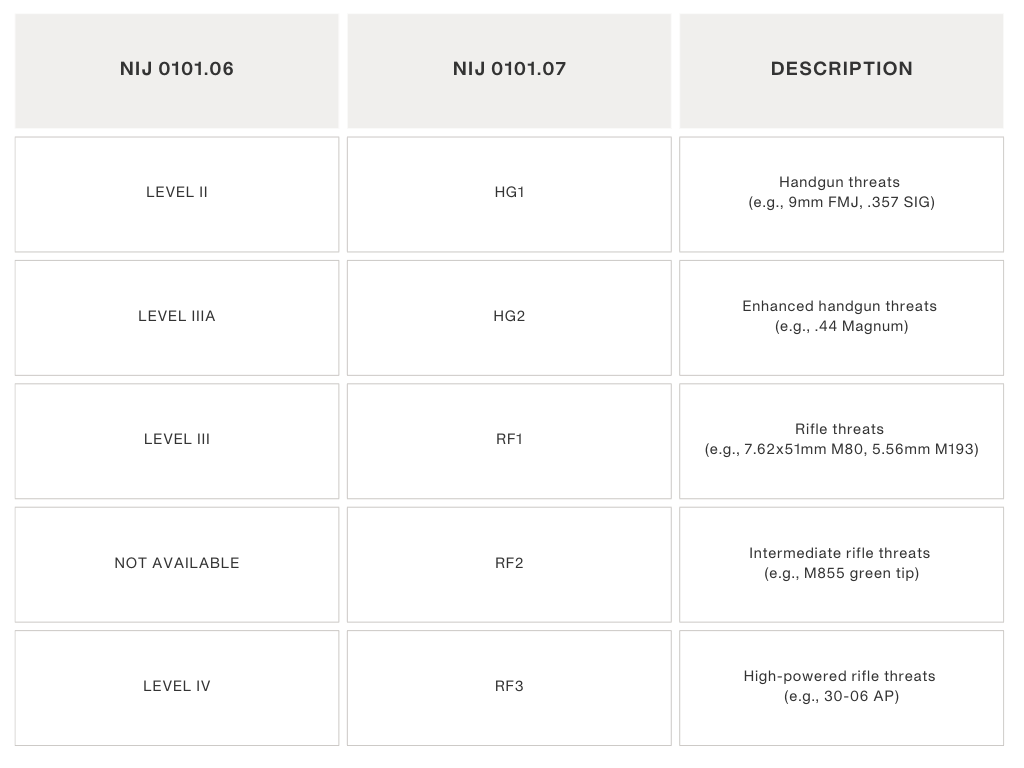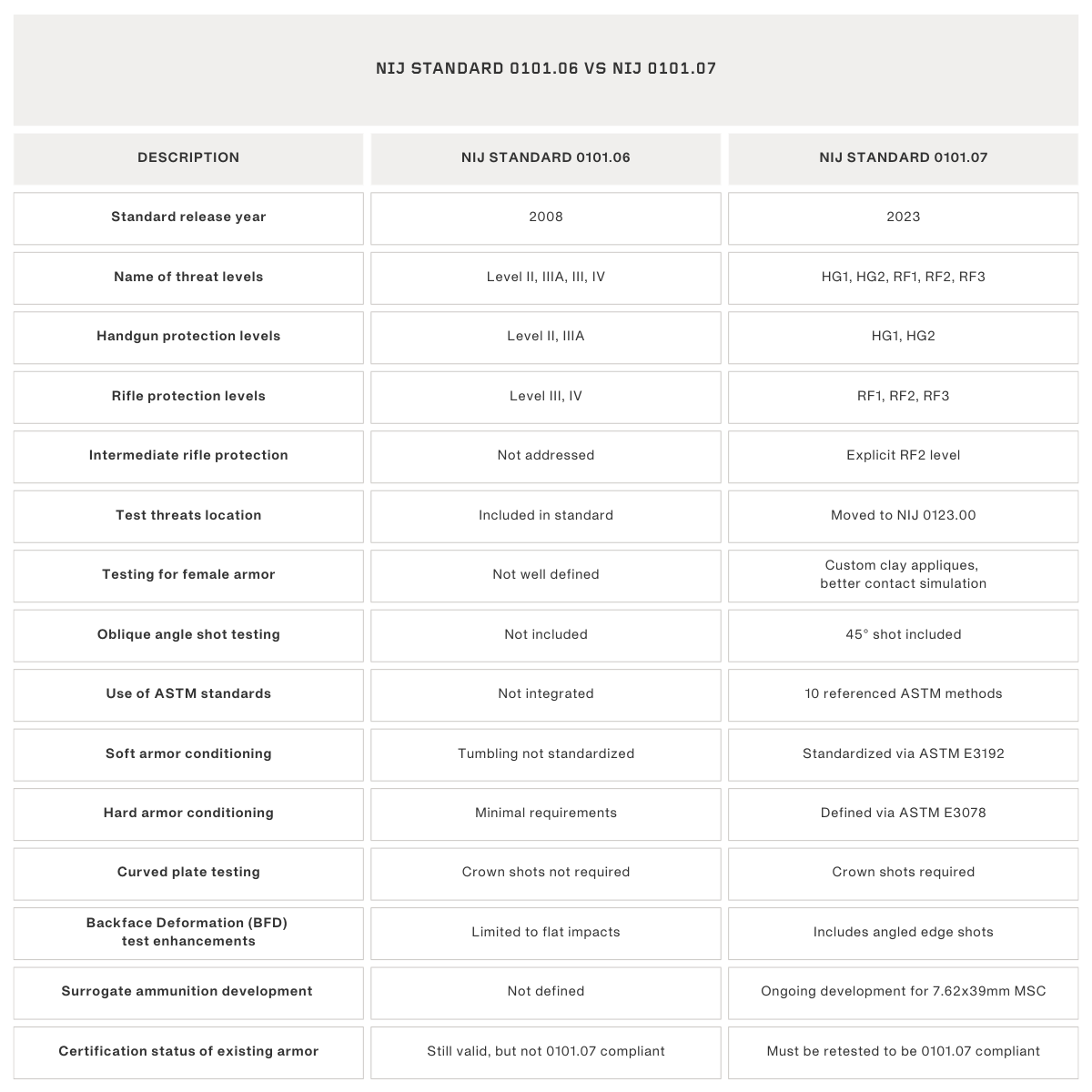
Home Office Body Armor Standard 2017 (Bulletproof vests)


The latest update brings some significant changes for how body armor is tested, certified, and used. It is critical that both manufacturers, procurement agencies, and end users understand the changes in NIJ 0101.07.
To summarize, the biggest change is actually the fact that the NIJ now operates according to two separate documents. They are:
This will create more flexibility for e.g. the NIJ and body armor manufacturers as they can respond and adjust to threat levels more quickly when new types of ammunition are used more frequently.
In this article, we will attempt to break down these key changes. Furthermore, we will explain why a new standard was needed, what it means for current body armor, and how PGD will adapt.
But let us kick off this article by explaining in more detail why NIJ 0101.07 was necessary.
It’s been quite some years since the last major update to NIJ body armor standards. We are actually going back to 2008, where NIJ 0101.06 was released. A lot has changed since then.
We have seen a development in criminal threats, a rise of female law enforcement officers, various types of ammunition, but also different manufacturing and testing techniques.
The NIJ also recognized these factors, and decided that testing protocols had to evolve accordingly.
We also know that law enforcement officers much more frequently now encounter rifle rounds like 5.56x45mm and 7.62x39mm and NIJ saw a major gap in the previous standard because they were not fully addressed under 0101.06.
Additionally, because of the growing presence of female law enforcement officers, the standard also needed to account for better-fitting, gender-specific armor and testing protocols to ensure women receive the same level of protection as men.
The familiar Level II, IIIA, III, and IV are replaced by:
This new naming system will hopefully improve clarity. The new naming – HG for handgun, and RF for rifle – communicates protection type and allows faster integration of future threat levels without breaking the system.

This means that they have moved threat levels and test ammunition to a completely separate standard in NIJ 0123.00, published in 2023. This change will allow the NIJ to update threats faster without having to rewrite the entire standard.
Earlier standards have often failed to reflect the realities of female torso armor. With NIJ 0101.07 a female body shape will be properly simulated and tested.
P-BFD testing is enhanced to better reflect real-world trauma.
“They changed the standard, should I be worried?”
In short, no. If you own body armor compliant with NIJ standard 0101.06, it won’t make the biggest difference. You are already well-protected. Don’t forget that.
It does however mean that it won’t meet the 0101.07 standard unless it is re-tested. The NIJ 0101.06 standard will most likely be of relevance for many years to come.
For end users: You can continue to use 0101.06-compliant armor, and it’s critical to understand that NIJ 0101.06 armor is not obsolete. You should also keep in mind that a lot of body armor today is already being tested against threats like 7.62×39 MSC and 5.56 M855. If so it will clearly be stated in the specs. Just like we do here at PGD so it is clear to understand exactly what kind of shots a given plate can withstand.
For manufacturers like PGD: It is important to remember that this is a transition, and it won’t happen overnight. Therefore, dual testing may be a strategy during the transition for many years. But ultimately, investing in 0101.07-compliant design will become the norm.
We should also not forget during the transition that the new HG1 and HG2 levels remain consistent to match the Level II and IIIA.
Things take time, and NIJ 0101.07 will be great for future buyers, but it does not make the existing body armor irrelevant in any way. Don’t panic!
There has been a lot of talk about the RF2 protection level in NIJ 0101.07. The reason is that it actually answers a question that has existed for ages, especially for law enforcement in the U.S.:
“How can we properly protect against common intermediate rifle threats, particularly the M855 green tip?”
RF1 (old level III) was insufficient against M855, while RF3 (old level IV) offered overkill with heavier plates.
RF2 bridges the gap by offering protection from:
From PGD’s perspective, this will eventually allow us to optimize weight and thickness without requiring full RF3-level protection. RF2 will fill in the gap and offer perfect balance between protection level and weight.
We see the NIJ 0101.07 transition as both a challenge and an opportunity.
PGD has always prioritized staying ahead of evolving threats. With RF2 and more nuanced test methods, the standard gives innovators space to fine-tune hybrid designs – like combining UHMWPE and ceramics for lighter RF2 plates or developing soft armor that better addresses angled handgun threats.
We will invest a lot of time in educating agencies, partners, and end users about this upcoming transition. But we have already been developing these plates for years. This proactive approach ensures our customers are equipped with gear that’s ready for the challenges of tomorrow.
E.g. We have already written an article about the problem in Sweden, where Swedish gangs now use military ammunition like fully jacketed 9x19mm m/39B bullets and armor-piercing rounds that will penetrate our PGD DELTA NIJ IIIA bulletproof vest. We recommend our PGD S-LW-ICW Super Lightweight hard armor NIJ level 3 (III+), which already provides protection against M80, AK47 and M193, but explained as a “special threat”.
RF2 would actually fill out that gap now.
We need to communicate the changing terminology and test metrics in the industry. This isn’t just about selling plates – it’s about making sure the right armor reaches the right mission profiles.
With the transition to NIJ 0101.07, armor materials and testing logistics grow more complex. PGD and others must work with accredited labs that understand the new ASTM references and can simulate nonplanar impacts, edge shots, and obliquity. Documentation and labeling standards are also a lot stricter.
We have created this comparison table between NIJ standard 0101.06 and NIJ 0101.07, where we try to highlight their major differences across testing, threat levels, methodology, and implications.
